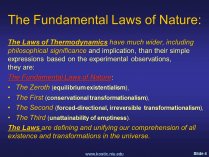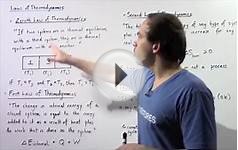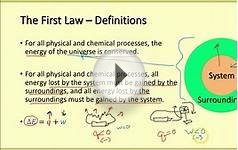The internal energy, , is a function of the state of the system. Thus , or , or . Recall that for pure substances the entire state of the system is specified if any two properties are specified. (We will discuss the equations that relate the internal energy to these other variables as the course progresses.)
- The change in energy of a system is equal to the difference between the heat added to the system and the work done by the system,
| (2..1) |
where is the energy of the system,
is the heat input to the system, and
is the work done by the system.
(thermal energy) +
- Like the Zeroth Law, the First Law describes the behavior of the new property [VW, S& B: Chapter 5].
- The equation can also be written on a per unit mass basis
- In many situations the potential energy, kinetic energy, and chemical energy of the system are constant or not important. Then
and - Note that and are not functions of state, but , which arises from molecular motion (see above), depends only on the state of the system; does not depend on how the system got to that state. We therefore have the striking result that:
Sometimes this difference is emphasized by writing the First Law in differential form,
(2..2)
where the symbol `` '' is used to denote that these are not exact differentials but rather are dependent on path. - Note that the signs are important:
- is defined to be positive if it is transferred to the system; thus the numerical value we substitute for will be positive if heat is transferred to the system from the surroundings, and negative if heat is transferred from the system to the surroundings. [VW, S & B: 4.7-4.8]
- is defined to be positive if it is done by the system (see Section 1.3); thus the numerical value we substitute for will be positive if the system is doing work, and negative if work is being done on the system. [VW, S& B: 4.1-4.4]
- For quasi-static processes we can substitute ,










